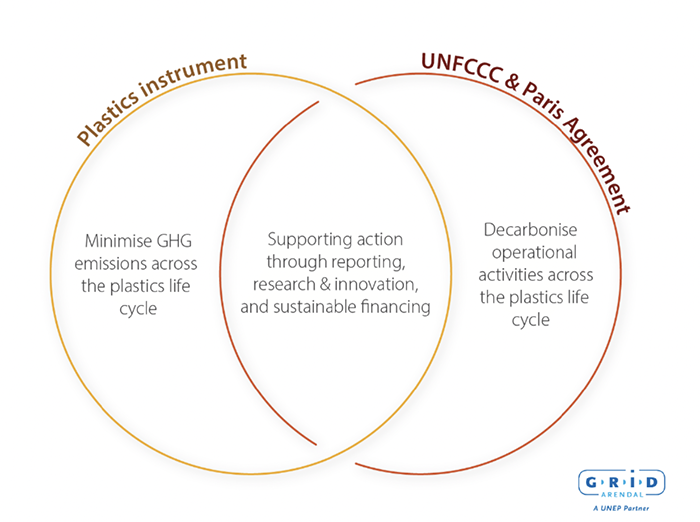By Natalia Skripnikova, GRID-Arendal
The sixth session of the UN Environment Assembly (UNEA-6) is focusing the discussion on multilateral actions to tackle climate change, biodiversity loss, and pollution. Multilateral actions are expected to give stronger support to efforts needed to address the triple planetary crisis. This can create momentum to build linkages between issues that might not be visible at first glance, calling for stronger synergies at the global level.
Plastic pollution and climate change at the intersection of the triple planetary crisis require coordinated environmental action and synergies between a global plastics agreement (currently being negotiated) and the UNFCCC and the Paris Agreement on climate change.
The recently published report titled, ‘Climate Impacts of Plastics: Global Actions to Stem Climate Change and End Plastic Pollution,’ outlines the options for measures to maximize climate benefits of the plastics instrument, taking into account the role and limitations of the UNFCCC and the Paris Agreement. It also calls for greater accountability and transparency of plastic-related emissions under the UNFCCC and the Paris Agreement and for synergies between the relevant multilateral environmental agreements (MEAs).
The plastics instrument and climate change
The report argues that development and implementation of the international legally binding instrument on plastic pollution provide a unique opportunity to strengthen global efforts in addressing climate change across the plastics life cycle. Scientific literature estimates that greenhouse gases (GHGs) are emitted throughout the entire life cycle of plastics, accounting for 3.8-4.5% of global GHG emissions. The plastic production stage accounts for 85% of GHG emissions across the plastics life cycle, and around 90% of global plastics production is dominated by fossil-based plastics.

Source: GRID-Arendal
Based on strong scientific evidence, and supported by attention given to climate action in countries’ submissions to the third session of Intergovernmental Negotiating Committee on Plastic Pollution, the instrument should:
- Explicitly recognize GHG emissions as a plastic pollutant;
- Reduce overall production of primary polymers by: reducing their use; increasing use of secondary plastics; phasing out problematic, unnecessary, and avoidable plastic products; and increasing use of low-carbon non-plastics substitutes;
- Limit GHG emissions by incorporating climate aspects in the design criteria, focusing on: employing low-carbon polymers; using polymers with low net energy requirements across the full life cycle, particularly production, that are suitable for reuse/refill systems and mechanical recycling; and minimizing the release of microplastics;
- Limit GHG emissions of waste management by: limiting open burning and other forms of mismanagement of plastic waste; and developing criteria to support the life cycle assessment of waste management facilities towards investment in lower-emitting technologies and avoiding lock-ins to high-emitting technologies;
- Highlight the critical need to address plastic pollution in the environment and its impacts on climate change through proactive measures on environmental and landfill remediation; and
- Strengthen trade control measures to include considerations of GHG emissions.
The plastic problem under the UNFCCC and the Paris Agreement
While the UNFCCC and the Paris Agreement have spearheaded global efforts to combat climate change, they have certain limitations in addressing the plastic problem and associated climate implications of it. The findings of the report reveal a lack of a comprehensive reporting mechanism to account for plastics’ contribution to climate change and to assess the effectiveness of mitigation actions to reduce emissions associated with plastics.
The main gaps identified are that:
- The current reporting mainly approaches the plastics industry as an integral element of the petrochemical and chemical industries, which leads to the absence of detailed and segregated data on measures taken to address climate impacts of plastics.
- The reporting on the plastics production stage, which is responsible for 85% of GHG emissions across the plastics life cycle, is fragmented and prevents transparent accounting of plastics’ contribution to climate change.
- The UNFCCC and the Paris Agreement provide an insufficient level of detail in covering decarbonization efforts and creating an overview of energy composition across the plastics life cycle, given that the plastics industry is closely integrated with other industries.
Is there a way forward?
One of the possible ways to stimulate global environmental action and maximize climate benefits is to forge better alignment between the global plastics agreement and the UNFCCC and the Paris Agreement. The instrument should align with the global goal set by the Paris Agreement to keep the global temperature increase below 2°C, preferably aiming for 1.5°C, compared with pre-industrial levels, and incentivize actions that both benefit climate and address plastic pollution. This could be further supported by acknowledging the instrument’s role in the protection of the climate system alongside its role in safeguarding human health and the environment.
The UNFCCC and the Paris Agreement should provide a platform for strengthening efforts to reduce and monitor GHG emissions across the plastics life cycle, particularly in relation to technological processes, energy use, and transport. It is paramount to tackle decarbonization of plastics to reduce overall emissions across the plastics’ life cycle, complementing efforts under the future plastics instrument.

Source: GRID-Arendal
Collaboration between the plastics instrument and the UNFCCC and the Paris Agreement should aim to:
- Promote research, innovation, and low-carbon technology development to expedite reduction of GHG emissions and to remove uncertainties related to certain technologies, like chemical conversion and carbon capture and utilization (CCU), before their inclusion in MEAs.
- Strengthen transparency and accountability by developing an indicator framework to track climate-related measures under the new plastics instrument and disaggregate plastics-related GHG emissions under the UNFCCC.
- Scale sustainable financing from public and private sources to address the climate component of plastics and emphasize the need for the financial sector to shift investments away from fossil-based and emissions-intensive petrochemical production.
Intricately linked, plastics and climate change threaten planetary health, biodiversity, and a safe environment. It is imperative to acknowledge these links and give them visibility so that integrated solutions can be found. Effective multilateralism and global collective action are instrumental to successfully tackle the triple planetary crisis.
* * *
Natalia Skripnikova is an Expert on Transboundary Governance and Environmental Crime at GRID-Arendal.